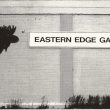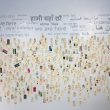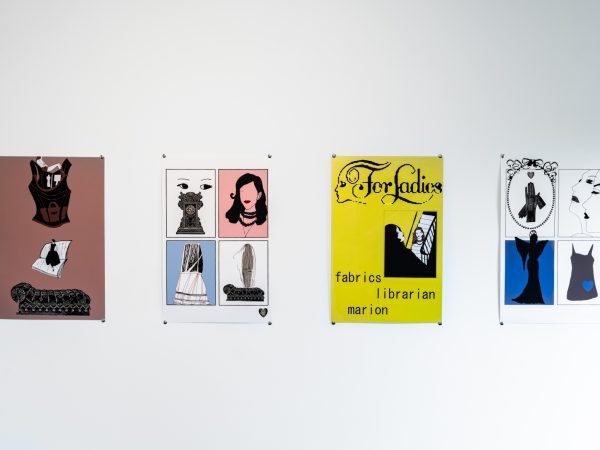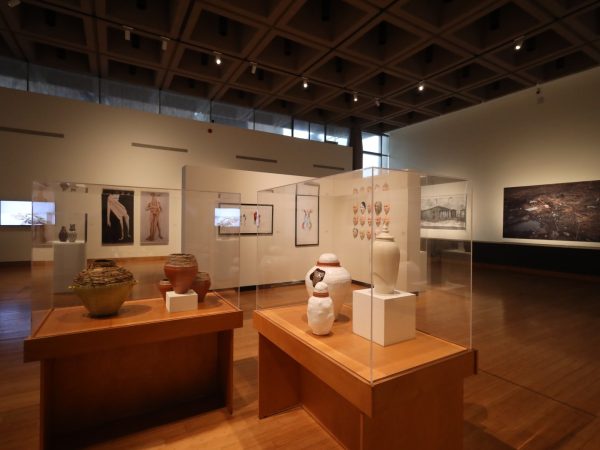Mi’kmaw artist Alan Syliboy’s retrospective The Journey So Far, curated by Pamela Edmonds at the Dalhousie Art Gallery (May 9 to August 11, 2024), spanned more than fifty years of work. The exhibition included paintings, collage, photography, music, print, mixed media, video, drums, and guitars and even a commissioned wall mural featuring a great horned serpent with red spots on a yellow spine.
“It’s not a typical snake. It’s magic. It can change and shift,” says Syliboy, who lives in Millbrook First Nation. “The snake is the imagination. It’s only temporary, a magic that appears and disappears. Eventually, it will be painted over. But it made an appearance,” he says, thereby reiterating the image’s significance.
The red-horned snake holds powerful medicines. The mural is based on Jipijka’m, a Mi’kmaw legend about a snake.
“For me it was important to have a mural in the gallery space. I think it’s a significant part of Alan’s art-making practice,” says curator Edmonds. “The great horned serpent is a mythological animal that takes on the shape of the space. It winds around the room into the alcove. It speaks to the stories and legends in the work.”
In a way, the snake moves with the viewer throughout the retrospective.
“It’s a protector, a medicinal protector that greets you and pulls you into the space,” says Edmonds. “It’s like the petroglyphs etched in stone that are disappearing due to the elements. The wall paint will still exist and will remain in the memory of the walls.
“The presence of the great horned snake will always be underneath and cannot be removed.”
The Journey So Far is a retrospective. Early on in his career, Syliboy was inspired by artists like Marc Chagall, J.M.W. Turner, and Carl Beam. The Journey So Far includes a landscape painting, “Whycocomagh Sunset” (1972), and collage works (Joe Julien and Members of the Grand Council, Grandfather, Grandmother 1 & 2, Baby Alan, and Young Alan, ca. 2012–2014) that feature black-and-white images of Syliboy as a baby and images of his grandmother Rachael Marshall, who introduced him to Shirley Bear.
Before attending Nova Scotia College of Art and Design University, Syliboy studied with Wolastoqiyik multimedia artist Shirley (Minqwôn-Minqwôn) Bear (1936–2022), who was a renowned poet, activist, and curator from Tobique First Nation.
“Shirley changed everything. She changed the world for me. As a student, I was a failure. I started to make cabinets at my uncle Fred’s cabinet shop,” says Syliboy. “I was making cabinets there, and Shirley came in to interview me for a project in the USA in the 1970s, an art project with the idea to do workshops in Native communities. It was really leading-edge.”
Back then, we Indigenous people weren’t allowed or invited to teach in our own communities. “Outsiders did all the teaching,” says Syliboy. “For us to teach our own people—it never happened before.”
Syliboy credits Bear for launching his art career and broadening his worldview. “My world was small until then. She took me out into the bigger world where there was art and possibilities,” he says. “At the time there weren’t many, if any, Native artists per se.”
Bear found Red Earth, a book of petroglyphs published by the Museum of Nova Scotia in 1971, which unearthed Syliboy’s ongoing fascination with the marks on the ground and symbols etched into rocks. “The petroglyphs were how we investigated our own identities. Mi’kmaw people didn’t know about petroglyphs,” he says. “It started things going for us, and the knowledge became deeper and wider. Opened up all kinds of alleys.”
Over the past five decades, Syliboy has exhibited nationally and internationally in solo and group shows. He is one of the most prolific and treasured artists in Mi’kma’ki. Syliboy left art school in the late 1960s; twenty-five years later he was invited to sit on NSCADU’s board of governors. In 2002, he received the Queen’s Golden Jubilee Medal, and in 2023 he was longlisted for the Sobey Art Award.
Syliboy credits social media as an important tool. Not only in terms of sharing his artwork, but also for connecting with folks all over the world. His social media posts roll out at first light every day and feature the Daily Drum, a photograph of one of his hundreds of hand-painted drums. Sometimes he’s holding the drum, for other images it’s placed on the earth.
His posts also include a personalized message about the Mi’kmaw teachings depicted on the drum. For example, on June 10, 2024, Syliboy posted on social media: “The whale’s wisdom extends beyond the boundaries of time and space, reminding us that we are all connected in the vast web of existence. Its presence invites us to embrace a sense of unity with all living beings.”
The Journey So Far was dreamlike and illustrated Syliboy’s vast, vivid, and vibrant interwoven creative practices. There was a deep sense of spirituality, magic, and various forms of play found throughout. Not only is Syliboy an artist who has been dedicated to visual art, drum-making, music, jam sessions, and animations, but he has also published several children’s books. His significant contribution to children’s literature includes When the Owl Calls Your Name (Nimbus Publishing, 2023), Wolverine and Little Thunder: An Eel Fishing Story (Nimbus, 2022), Mi‘kmaw Daily Drum: Mi‘kmaw Culture for Every Day of the Week (Nimbus, 2020), Mi‘kmaw Wasisik / Mi‘kmaw Animals (Nimbus, 2018), and Kaqtukowateketew / The Thundermaker (Nimbus, 2018), which is translated by Lindsay R. Marshall. The retrospective included storyboards from these children’s books.
“Alan’s work teaches us about the importance of memory and of cultural heritage. He is preserving the culture by bringing the lost stories and language to his community,” says Edmonds. “Also by sharing it with a broader community. When he reads the stories to the kids, they know the Mi’kmaw words. These are children from all cultural backgrounds. It’s quite moving to see [on] how many levels he has been able to really have an impact.”
Edmonds first met Syliboy when she was an emerging curator in Kjipuktuk/Halifax in the late 1990s. As part of her own curatorial practice, she was interested in artists who were engaged in grassroots activism.
“I don’t think Alan would consider his work activism, but he is focused on communities and bringing communities together, first and foremost the Mi’kmaw community and Mi’kmaw culture.”
Edmonds contextualizes Syliboy’s work as an important link between contemporary art and Mi’kmaw culture and art, but she wasn’t seeing his work engaged with on national or international levels. This is why she nominated him for a Sobey Art Award last year and is working with Syliboy on a catalogue for major publication as part of The Journey So Far retrospective.
“Alan’s work should be included in major exhibitions of Indigenous art on the national and international scale,” she says. “His work is very important in Mi’kma’ki but also to the broader conversation around Indigenous art in Canada, Turtle Island, and beyond.”
The Journey So Far was a survey exhibition that offered an insight into Syliboy’s long-standing career and ongoing shifts in creative praxis. “I was very struck by Alan as an artist, in particular his drawings, and how they are related to culture and history,” says Edmonds. “I think he’s an amazing artist in terms of his drawings—the graphic quality and the strong spiritual presence.”
Early sketches and pieces included in the retrospective are from private collector Marcia Hennessy, who collected over one hundred of Syliboy’s works during her lifetime. And in a way, this relationship offers an insight into Syliboy’s remarkable journey. Via letters, Christmas cards, and emails, viewers catch a glimpse of the connection between the artist and the collector, as well as Hennessy’s deep admiration of Syliboy’s work. As part of his retrospective, Syliboy wanted to celebrate Hennessy and the significant impact she had on supporting him as an artist and as a single father.
When Hennessy first discovered Syliboy’s work at Bay of Spirits Gallery in Toronto, she bought a few pieces of his art. And then a few more. At the time, the gallery asked Syliboy if he could make a special picture or write a note for Hennessy because she was such a unique client. From there, Hennessy found Syliboy’s work online. “She would buy directly from me from then on. That’s how our relationship started,” says Syliboy.
The two only ever met in person once when Syliboy had an exhibition (Homeboys, with Alex Janvier) at the Art Gallery of Nova Scotia in 2001. She came for the exhibition and stayed to visit with him for a few days.
“I never did see her again, but she would call me from time to time,” says Syliboy. Hennessy continued to collect Syliboy’s work online, and the two stayed in touch. She had always planned to come back to Nova Scotia, but her health deteriorated. Hennessy crossed over to the spirit world in 2020.
“Marcia only collected one artist, and that was me. And she only listened to [Canadian pianist] Glenn Gould,” he says. “So, there was only me and Glenn Gould in her house.” The collector even sent Syliboy an entire collection of Gould’s recordings on CD. “Glenn Gould is brilliant. She wanted Glenn Gould and I together, so I painted a series while listening to Glenn. [His music] affected my work.”
Syliboy acknowledges how incredibly grateful he was for Hennessy’s support and their long friendship. He always gave her first dibs on his artwork.
“I was a single parent on welfare. To have support like that is absolutely amazing. She really helped me bring these kids up,” says Syliboy. “We were very close that way. She was always in my corner. She helped me provide for my kids, which was very important. Marcia would send them cards at Christmas and some money. An incredible person.”
From a curatorial perspective, Edmonds wants to highlight the importance of relationships and to demystify the capitalistic conventions often seen in the art world. Artists need financial support beyond grants and exhibition fees to maintain their practices.
“It was an interesting way to build a story around Alan’s work, which has changed so much over the past thirty years,” she says. “Marcia wasn’t necessarily a woman of wealthy means, but she was someone who loved his art and bought it.
“She had Alan’s work all over her home, even with modest means. I wanted to show the importance of supporting artists. It humanizes the artist and artist supporters.”
My favourite of Syliboy’s earlier works in the retrospective, Home (1999, pencil and acrylic on paper), comes from Hennessy’s private collection. I was initially drawn by the great horned serpent into the abstract swirls of forest greens and soft and deep blue shades and was delighted by the bright red sun with brilliant yellow. But upon closer examination, it was the greens, blues and dreamy light pinks of the geometric forms that captivated me. As I gazed longer at the recurring symbols, curves, and pastels of Syliboy’s cosmology, admiring the intricate pencil drawings, I looked back at the mural. And for a moment, I felt humbled by the great horned serpent who guided me there and then to the ancestors. But most of all I felt connected and grateful to Syliboy for continually sharing his journey thus far.
















Leave a Reply